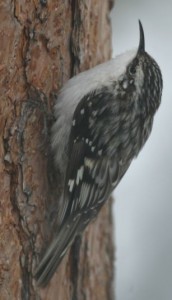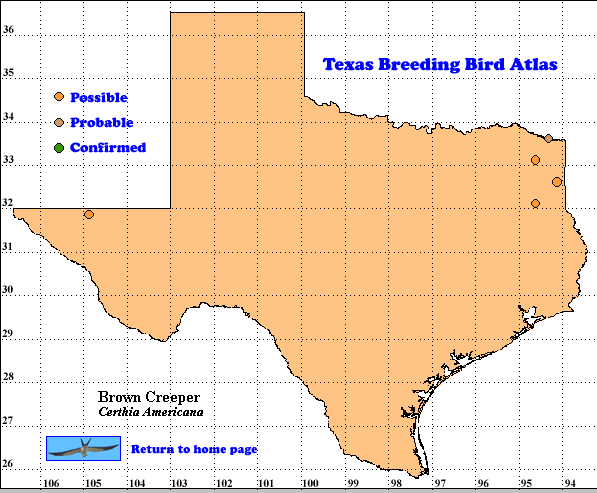This inconspicuous bird is more often heard than seen, although its soft, high-pitched calls do no carry far, making censusing difficult. This may explain low relative abundance figures from North American Breeding Bird Survey (BBS) data and very few areas have relative abundances higher than 3 creepers per BBS route.(Sauer et al. 2005).
Brown Creeper is the only New World member of the Old World Treecreeper genus and was once considered conspecific with th Eurasian Treecreeper (C. familiaris). The irregular distribution of Brown Creeper in North and Middle America suggests the possibility of more than one population group existing. A recent description of vocal differences between eastern and western Brown Creepers and among western subspecies further strengthens the desirability of further research (Sibley 2000, Hejl et al. 2002).
DISTRIBUTION. During the 1987-1992 field work seasons of the TBBA project, atlasers found one probable record in latilong 33094, quad E4 and 3 possibles: 33094-B6 and 32094, quads A5 and F2 in northeast Texas. Two possible records were also found in 31104-H7 in the Guadalupe Mountains where breeding has been reported previously (Oberholser 1974). BBS data from adjoining areas of New Mexico indicate relative abundances as high as 1-3 creepers per route per year (Sauer et al. 2005).
East Texas observations require further study as the Oklahoma Breeding Bird Atlas does not report this species from field work there (Reinking 2004). Although BBS data does not indicate breeding in the Gulf Coast states (Sauer et al. 2005) breeding by Brown Creepers in lowland bald cypress and tupelo swamps has been reported in these states in recent years (Hejl et al. 2002).
The BBS data (Sauer et al. 2005) and that gathered by Hejl et al. (2002) produce an interesting picture of the range used by this creeper. On the Pacific Coast a resident population extends from southern Alaska through the coastal forests and mountains to southern California. Other creeps breed in the Rocky Mountains and south through the highlands of Mexico and Central America to Nicaragua. A breeding population extends across southern Canada from eastern Alberta to Newfoundland which moves southward in winter. Another resident population breeds in the upper Midwestern and Northeastern states and the Appalachian Mountains. In winter migrants spread through almost all the non-breeding area in the United States and into northeast Mexico.
SEASONAL OCCURRENCE. More Brown Creepers are present in Texas during the winter and in migration than in summer. Migrants and winter visitors are found in Texas from August 1 to June 27 with most arriving after late October and leaving by late April (Oberholser 1974, Lockwood and Freeman 2004). In Arizona most breeding occurs from mid-April to early August (Friederici 2005).
BREEDING HABITAT. A nest was found in the Guadalupe Mountains above 2400 m (8000 ft; Oberholser 1974). In Arizona where atlasers recorded habitats of breeding sites, 79% of breeding records came from habitats dominated by ponderosa and pinyon pines (Friederici 2005) and in Colorado about three-quarters of breeding records came from coniferous habitats (Jones 1998). The nest is almost always placed between loose bark and the trunk of a large dead or dying tree. The female builds a base of twigs and strips of bark, bound together and to the bark with spider-egg cases and insect cocoons to form a hammock-like structure. The nest cup is built in the center of the base of a variety of fine plant materials, hair and feathers (Hejl et al. 2002). See Harrison (1979) for photos of nests.
The female usually lays 5-6 (range 1-8) smooth, white eggs, speckled with pink to reddish- brown dots. The eggs are similar to those of Black-capped Chickadee (Poecile atrica- pillus; Harrison 1979). The female incubates the eggs for 15-17 days and her mate feeds her on the nest. The young birds leave the nest 14-20 days after hatching. Probably only 1 brood is raised per year (Harrison 1979, Hejl et al. 2002).
STATUS. Estimates of migratory and winter abundance vary from common to fairly common in the eastern three-quarters of the state north of the 29th parallel (Oberholser 1974) to uncommon to rare in the northern three-quarters of the state (Lockwood and Freeman 2004), who consider this species to be an uncommon summer resident in the Guadalupe Mountains. The BBS method does not sample Brown Creeper in Texas, but data from the 288 routes in the western United States produce an average annual population change of -2.3% (significant at the 99% level) for the period 1980-2005 (Sauer et al. 2005). The effects of global climate change on the limited habitat of this species in the Guadalupe Mountains will probably be the major factor determining its future as a breeder in Texas.
Text by Robert C. Tweit (2006)
Literature cited.
Friederici, P. 2005. Brown Creeper (Certhia americana) In Arizona breeding bird atlas. pp. 400-401 (T. E. Corman and C. Wise-Gervais, eds.), University of New Mexico Press, Albuquerque.
Harrison, H. H. 1979. A field guide to western birds’ nests. Houghton Mifflin, Boston, MA.
Hejl, S. J., K. R. Newlon, M. E. MacFadzen, J. S. Young and C. K. Ghalambor . 2002. Brown Creeper (Certhia americana). In The birds of North America, No. 669 (A. Poole and F. Gill, eds.). The Birds of North America, Inc., Philadelphia, PA.
Howell, S. N. G. and S. Webb. 1995. A guide to the birds of Mexico and northern Central America. Oxford University Press, New York.
Jones, S. L. 1998. Brown Creeper (Certhia americana). In Colorado breeding bird atlas, pp. 360-361 (H. E. Kingery, ed.), Colorado Bird Atlas Partnership, Denver.
Lockwood, M. W. and B. Freeman. 2004. The TOS handbook of Texas birds. Texas A&M University Press, College Station.
Oberholser, H. C. 1974. The bird life of Texas. University of Texas Press, Austin.
Reinking, D. L., ed. 2004. Oklahoma breeding bird atlas. University of Oklahoma Press, Norman.
Sauer, J. R., J. E. Hines, and J. Fallon. 2005. The North American Breeding Bird Survey, results and analysis 1966-2005. Version 6.2 2006. USGS Patuxent Wildlife Research Center, Laurel MD < http://www.mbr-pwrc.usgs.gov/bbs>
Sibley, D. A. 2000. The Sibley guide to birds. Chanticleer Press, New York.

